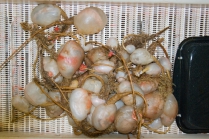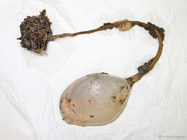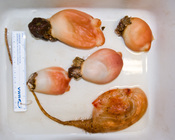WoRMS taxon details
Boltenia ovifera (Linnaeus, 1767)
103815 (urn:lsid:marinespecies.org:taxname:103815)
accepted
Species
Ascidia clavata Mueller, 1776 · unaccepted (homonym)
Ascidia globifera Lamarck, 1816 · unaccepted (original combination)
Boltenia beringi Dall, 1872 · unaccepted (literature misspelling)
Boltenia beringia Dall, 1872 · unaccepted (original combination)
Boltenia bolteni (Linnaeus, 1771) · unaccepted (new combination)
Boltenia burkhardti Binney, 1870 · unaccepted (original combination)
Boltenia ciliata Moeller, 1842 · unaccepted (original combination)
Boltenia clavata Mueller, 1776 · unaccepted (original combination)
Boltenia elegans Herdman, 1881 · unaccepted (original combination)
Boltenia fusiformis Savigny, 1816 · unaccepted (original combination)
Boltenia microcosmus Agassiz, 1850 · unaccepted (original combination)
Boltenia oviformis (Linnaeus, 1767) · unaccepted (literature misspelling)
Boltenia reniformis MacLeay, 1825 · unaccepted (original combination)
Boltenia rubra Stimpson, 1852 · unaccepted (original combination)
Boltenia thompsoni Hartmeyer, 1903 · unaccepted (original combination)
Pyura ovifera (Linnaeus, 1767) · unaccepted (new combination)
Pyura thompsoni (Hartmeyer, 1903) · unaccepted (new combination)
Vorticella bolteni Linnaeus, 1771 · unaccepted (original combination)
Vorticella ovifera Linnaeus, 1767 · unaccepted (original combination)
marine, fresh, terrestrial
(of Vorticella ovifera Linnaeus, 1767) Linnaeus, C. (1767). Systema naturae per regna tria naturae: secundum classes, ordines, genera, species, cum characteribus, differentiis, synonymis, locis. Ed. 12. 1., Regnum Animale. 1 & 2. [The system of nature through the three kingdoms of nature: according to classes, orders, genera, species, with characters, differences, synonyms, places. Ed. 12. 1., Animal Kingdom. 1 & 2]. <em>Holmiae [Stockholm], Laurentii Salvii.</em> pp. 1-532 [1766] pp. 533-1327 [1767]., available online at http://www.biodiversitylibrary.org/item/83650#5 [details] 
Distribution Arctic south to Cape Cod
Distribution Arctic south to Cape Cod [details]
Shenkar, N.; Gittenberger, A.; Lambert, G.; Rius, M.; Moreira da Rocha, R.; Swalla, B.J.; Turon, X. (2025). Ascidiacea World Database. Boltenia ovifera (Linnaeus, 1767). Accessed through: World Register of Marine Species at: https://www.marinespecies.org/aphia.php?p=taxdetails&id=103815 on 2025-04-26
![]() The webpage text is licensed under a Creative Commons
Attribution 4.0 License
The webpage text is licensed under a Creative Commons
Attribution 4.0 License
Nomenclature
original description
(of Ascidia globifera Lamarck, 1816) Lamarck, [J.-B. M.] de. (1816). <i>Histoire naturelle des animaux sans vertèbres</i>, Tome troisième, 586 pp. Paris, Deterville/Verdière. , available online at http://www.biodiversitylibrary.org/item/47702 [details] 
original description (of Boltenia burkhardti Binney, 1870) Gould, A. A. (1870). <i>Report on the Invertebrata of Massachusetts</i>. Second edition, comprising the Mollusca. Edited by W.G. Binney. Wright and Potter, Boston, v + 524 pp., pls. 16–27. , available online at https://www.biodiversitylibrary.org/page/10897088 [details]
original description (of Boltenia ciliata Moeller, 1842) Moeller, H. P. C. (1842). Index molluscorum Groenlandiae. <em>Naturh. Tidsskr.</em> 4: 76-97. [details]
original description (of Boltenia clavata Mueller, 1776) Müller, O.F. (1776). Zoologiae Danicae prodromus, seu Animalium Daniae et Norvegiae indigenarum: characteres, nomina, et synonyma imprimis popularium. [Prodrome of Danish Zoology, or the Native Animals of Denmark and Norway: the characters, names, and synonyms of the most popular ones.]. <em>Typis Hallagerii, Havni, Copenhagen.</em> 282 pp., available online at http://www.biodiversitylibrary.org/item/47550 [details]
original description (of Boltenia elegans Herdman, 1881) Herdman, W. A. (1881). Preliminary report on the Tunicata of the Challenger expedition. Cynthiidae. <em>Proceeding of the Royal Society of Edinburgh.</em> 11(3): 52-88., available online at https://www.biodiversitylibrary.org/page/48710941 [details]
original description (of Boltenia fusiformis Savigny, 1816) Savigny, J. C. (1816). Memoires sur les animaux sans vertebres. <em>Paris.</em> 2: 1-239. [details]
original description (of Boltenia microcosmus Agassiz, 1850) Agassiz, L. (1850). On the embryology of Ascidia and the characteristis of new species from the shores of Massachusetts. <em>Proc. Amer. Assoc. Adv. Sci.</em> 2: 157-159. [details]
original description (of Boltenia reniformis MacLeay, 1825) MacLeay, W. S. (1825). Anatomical observations on the natural group of the Tunicata, with the description of three species collected in Fox Channel. <em>Trans. Linnean Soc. London.</em> 14: 527-555. [details]
original description (of Boltenia rubra Stimpson, 1852) Stimpson, W. (1852). Several new ascidians from the coast of the United States. <em>Proc. Boston Soc. Nat. Hist.</em> 4: 228-232. [details]
original description (of Boltenia thompsoni Hartmeyer, 1903) Hartmeyer, R. (1903). Die Ascidien der Arktis. <em>In: Romer, F. & F. Schaudin eds., Fauna Arctica.</em> 3(2): 93-412. ((present only pp.0-341!!)). [details]
original description (of Vorticella bolteni Linnaeus, 1771) Linnaeus C. (1771). Mantissa plantarum: Generum editionis VI. et specierum editionis II. L. Salvius, Holmiae. Vol. Mantissa [2] altera: Regni Animalis Appendix: 521-552. , available online at https://www.biodiversitylibrary.org/page/42945322 [details]
original description (of Vorticella ovifera Linnaeus, 1767) Linnaeus, C. (1767). Systema naturae per regna tria naturae: secundum classes, ordines, genera, species, cum characteribus, differentiis, synonymis, locis. Ed. 12. 1., Regnum Animale. 1 & 2. [The system of nature through the three kingdoms of nature: according to classes, orders, genera, species, with characters, differences, synonyms, places. Ed. 12. 1., Animal Kingdom. 1 & 2]. <em>Holmiae [Stockholm], Laurentii Salvii.</em> pp. 1-532 [1766] pp. 533-1327 [1767]., available online at http://www.biodiversitylibrary.org/item/83650#5 [details]
original description (of Ascidia clavata Mueller, 1776) Müller, O.F. (1776). Zoologiae Danicae prodromus, seu Animalium Daniae et Norvegiae indigenarum: characteres, nomina, et synonyma imprimis popularium. [Prodrome of Danish Zoology, or the Native Animals of Denmark and Norway: the characters, names, and synonyms of the most popular ones.]. <em>Typis Hallagerii, Havni, Copenhagen.</em> 282 pp., available online at http://www.biodiversitylibrary.org/item/47550 [details]
original description (of Boltenia beringia Dall, 1872) Dall, W. H. (1871). Descriptions of sixty new forms of mollusks and brachiopods of the southeastern coast of North America and the North Pacific Ocean, with notes on others already described. <em>American Journal of Conchology.</em> 7(2): 93-159, pl. 13-16., available online at https://www.biodiversitylibrary.org/page/15918246 [details]
basis of record Monniot, C. (2001). Ascidiacea & Sorberacea. <em>In: Costello, M.J. et al. (Ed.) (2001). European register of marine species: a check-list of the marine species in Europe and a bibliography of guides to their identification. Collection Patrimoines Naturels.</em> 50: pp. 352-355. (look up in IMIS) [details]
original description (of Boltenia burkhardti Binney, 1870) Gould, A. A. (1870). <i>Report on the Invertebrata of Massachusetts</i>. Second edition, comprising the Mollusca. Edited by W.G. Binney. Wright and Potter, Boston, v + 524 pp., pls. 16–27. , available online at https://www.biodiversitylibrary.org/page/10897088 [details]
original description (of Boltenia ciliata Moeller, 1842) Moeller, H. P. C. (1842). Index molluscorum Groenlandiae. <em>Naturh. Tidsskr.</em> 4: 76-97. [details]
original description (of Boltenia clavata Mueller, 1776) Müller, O.F. (1776). Zoologiae Danicae prodromus, seu Animalium Daniae et Norvegiae indigenarum: characteres, nomina, et synonyma imprimis popularium. [Prodrome of Danish Zoology, or the Native Animals of Denmark and Norway: the characters, names, and synonyms of the most popular ones.]. <em>Typis Hallagerii, Havni, Copenhagen.</em> 282 pp., available online at http://www.biodiversitylibrary.org/item/47550 [details]
original description (of Boltenia elegans Herdman, 1881) Herdman, W. A. (1881). Preliminary report on the Tunicata of the Challenger expedition. Cynthiidae. <em>Proceeding of the Royal Society of Edinburgh.</em> 11(3): 52-88., available online at https://www.biodiversitylibrary.org/page/48710941 [details]
original description (of Boltenia fusiformis Savigny, 1816) Savigny, J. C. (1816). Memoires sur les animaux sans vertebres. <em>Paris.</em> 2: 1-239. [details]
original description (of Boltenia microcosmus Agassiz, 1850) Agassiz, L. (1850). On the embryology of Ascidia and the characteristis of new species from the shores of Massachusetts. <em>Proc. Amer. Assoc. Adv. Sci.</em> 2: 157-159. [details]
original description (of Boltenia reniformis MacLeay, 1825) MacLeay, W. S. (1825). Anatomical observations on the natural group of the Tunicata, with the description of three species collected in Fox Channel. <em>Trans. Linnean Soc. London.</em> 14: 527-555. [details]
original description (of Boltenia rubra Stimpson, 1852) Stimpson, W. (1852). Several new ascidians from the coast of the United States. <em>Proc. Boston Soc. Nat. Hist.</em> 4: 228-232. [details]
original description (of Boltenia thompsoni Hartmeyer, 1903) Hartmeyer, R. (1903). Die Ascidien der Arktis. <em>In: Romer, F. & F. Schaudin eds., Fauna Arctica.</em> 3(2): 93-412. ((present only pp.0-341!!)). [details]
original description (of Vorticella bolteni Linnaeus, 1771) Linnaeus C. (1771). Mantissa plantarum: Generum editionis VI. et specierum editionis II. L. Salvius, Holmiae. Vol. Mantissa [2] altera: Regni Animalis Appendix: 521-552. , available online at https://www.biodiversitylibrary.org/page/42945322 [details]
original description (of Vorticella ovifera Linnaeus, 1767) Linnaeus, C. (1767). Systema naturae per regna tria naturae: secundum classes, ordines, genera, species, cum characteribus, differentiis, synonymis, locis. Ed. 12. 1., Regnum Animale. 1 & 2. [The system of nature through the three kingdoms of nature: according to classes, orders, genera, species, with characters, differences, synonyms, places. Ed. 12. 1., Animal Kingdom. 1 & 2]. <em>Holmiae [Stockholm], Laurentii Salvii.</em> pp. 1-532 [1766] pp. 533-1327 [1767]., available online at http://www.biodiversitylibrary.org/item/83650#5 [details]
original description (of Ascidia clavata Mueller, 1776) Müller, O.F. (1776). Zoologiae Danicae prodromus, seu Animalium Daniae et Norvegiae indigenarum: characteres, nomina, et synonyma imprimis popularium. [Prodrome of Danish Zoology, or the Native Animals of Denmark and Norway: the characters, names, and synonyms of the most popular ones.]. <em>Typis Hallagerii, Havni, Copenhagen.</em> 282 pp., available online at http://www.biodiversitylibrary.org/item/47550 [details]
original description (of Boltenia beringia Dall, 1872) Dall, W. H. (1871). Descriptions of sixty new forms of mollusks and brachiopods of the southeastern coast of North America and the North Pacific Ocean, with notes on others already described. <em>American Journal of Conchology.</em> 7(2): 93-159, pl. 13-16., available online at https://www.biodiversitylibrary.org/page/15918246 [details]
basis of record Monniot, C. (2001). Ascidiacea & Sorberacea. <em>In: Costello, M.J. et al. (Ed.) (2001). European register of marine species: a check-list of the marine species in Europe and a bibliography of guides to their identification. Collection Patrimoines Naturels.</em> 50: pp. 352-355. (look up in IMIS) [details]
Other
context source (Deepsea)
Intergovernmental Oceanographic Commission (IOC) of UNESCO. The Ocean Biogeographic Information System (OBIS), available online at http://www.iobis.org/ [details]
additional source Bromley, J.E.C. & J.S. Bleakney. (1985). Keys to the fauna and flora of Minas Basin. <em>National Research Council of Canada Report, Halifax, N.S.</em> 24119: 366 PP. [details]
additional source Gosner, K. L. (1971). Guide to identification of marine and estuarine invertebrates: Cape Hatteras to the Bay of Fundy. <em>John Wiley & Sons, Inc., London.</em> 693 pp. [pdf copepod and branchiuran :445-455]. (look up in IMIS) [details] Available for editors [request]
[request]
additional source Linkletter, L. E. (1977). A checklist of marine fauna and flora of the Bay of Fundy. <em>Huntsman Marine Laboratory, St. Andrews, N.B.</em> 68: p. [details]
additional source Logan, A. (1998). A sublittoral hard substrate epibenthic community below 30 m in Head Harbour Passage, New Brunswick, Canada. <em>Estuarine, Coastal and Shelf Science.</em> 27: 445-459. [details]
additional source Miner, R. W. (1950). Field book of seashore life. <em>G.P. Putnam & Sons.</em> 1-888. [details]
additional source Thomas, M. L. H. (1983). Marine and coastal systems of the Quoddy Region, New Brunswick. <em>Canadian Special Publication of Fisheries and Aquatic Sciences.</em> 64:1-306. [details] Available for editors [request]
[request]
additional source Van Name, W. G. (1945). The North and South American ascidians. <em>Bull. Amer. Mus. Nat. Hist.</em> 84: 1-476., available online at http://digitallibrary.amnh.org/dspace/handle/2246/1186 [details]
additional source Gosner, K.L. (1979). A Field Guide to the Atlantic Seashore. Invertebrates and Seaweeds of the Atlantic Coast from the Bay of Fundy to Cape Hatteras. <em>Wiley-Interscience, Boston.</em> 329pp., figs. 1-72, pls. 1-64. [pdf copepods only]. [details] Available for editors [request]
[request]
additional source Trott, T. J. (2004). Cobscook Bay inventory: a historical checklist of marine invertebrates spanning 162 years. <em>Northeastern Naturalist.</em> 11, 261-324., available online at http://www.gulfofmaine.org/kb/files/9793/TROTT-Cobscook%20List.pdf [details] Available for editors [request]
[request]
additional source Integrated Taxonomic Information System (ITIS). , available online at http://www.itis.gov [details]
additional source van der Land, J. (ed). (2008). UNESCO-IOC Register of Marine Organisms (URMO). , available online at http://www.marinespecies.org/urmo/ [details]
additional source Bromley, J.E.C. & J.S. Bleakney. (1985). Keys to the fauna and flora of Minas Basin. <em>National Research Council of Canada Report, Halifax, N.S.</em> 24119: 366 PP. [details]
additional source Gosner, K. L. (1971). Guide to identification of marine and estuarine invertebrates: Cape Hatteras to the Bay of Fundy. <em>John Wiley & Sons, Inc., London.</em> 693 pp. [pdf copepod and branchiuran :445-455]. (look up in IMIS) [details] Available for editors
additional source Linkletter, L. E. (1977). A checklist of marine fauna and flora of the Bay of Fundy. <em>Huntsman Marine Laboratory, St. Andrews, N.B.</em> 68: p. [details]
additional source Logan, A. (1998). A sublittoral hard substrate epibenthic community below 30 m in Head Harbour Passage, New Brunswick, Canada. <em>Estuarine, Coastal and Shelf Science.</em> 27: 445-459. [details]
additional source Miner, R. W. (1950). Field book of seashore life. <em>G.P. Putnam & Sons.</em> 1-888. [details]
additional source Thomas, M. L. H. (1983). Marine and coastal systems of the Quoddy Region, New Brunswick. <em>Canadian Special Publication of Fisheries and Aquatic Sciences.</em> 64:1-306. [details] Available for editors
additional source Van Name, W. G. (1945). The North and South American ascidians. <em>Bull. Amer. Mus. Nat. Hist.</em> 84: 1-476., available online at http://digitallibrary.amnh.org/dspace/handle/2246/1186 [details]
additional source Gosner, K.L. (1979). A Field Guide to the Atlantic Seashore. Invertebrates and Seaweeds of the Atlantic Coast from the Bay of Fundy to Cape Hatteras. <em>Wiley-Interscience, Boston.</em> 329pp., figs. 1-72, pls. 1-64. [pdf copepods only]. [details] Available for editors
additional source Trott, T. J. (2004). Cobscook Bay inventory: a historical checklist of marine invertebrates spanning 162 years. <em>Northeastern Naturalist.</em> 11, 261-324., available online at http://www.gulfofmaine.org/kb/files/9793/TROTT-Cobscook%20List.pdf [details] Available for editors
additional source Integrated Taxonomic Information System (ITIS). , available online at http://www.itis.gov [details]
additional source van der Land, J. (ed). (2008). UNESCO-IOC Register of Marine Organisms (URMO). , available online at http://www.marinespecies.org/urmo/ [details]
 Present
Present  Present in aphia/obis/gbif/idigbio
Present in aphia/obis/gbif/idigbio  Inaccurate
Inaccurate  Introduced: alien
Introduced: alien  Containing type locality
Containing type locality
From editor or global species database
Genetic nomenclature abbreviation Btovif [details]Unreviewed
Diet plankton feeder [details]Dimensions length 75 mm or more [details]
Distribution Arctic south to Cape Cod [details]
Habitat bathyal, infralittoral and circalittoral of the Gulf and estuary [details]
Reproduction hermaphroditic; eggs shed and fertilized in the water [details]
To Barcode of Life (5 barcodes)
To Biodiversity Heritage Library (10 publications) (from synonym Boltenia oviformis (Linnaeus, 1767))
To Biodiversity Heritage Library (11 publications) (from synonym Boltenia ciliata Moeller, 1842)
To Biodiversity Heritage Library (14 publications) (from synonym Boltenia bolteni (Linnaeus, 1771))
To Biodiversity Heritage Library (17 publications) (from synonym Boltenia elegans Herdman, 1881)
To Biodiversity Heritage Library (20 publications) (from synonym Boltenia rubra Stimpson, 1852)
To Biodiversity Heritage Library (21 publications) (from synonym Boltenia clavata Mueller, 1776)
To Biodiversity Heritage Library (22 publications) (from synonym Boltenia fusiformis Savigny, 1816)
To Biodiversity Heritage Library (23 publications) (from synonym Ascidia globifera Lamarck, 1816)
To Biodiversity Heritage Library (3 publications) (from synonym Pyura thompsoni (Hartmeyer, 1903))
To Biodiversity Heritage Library (35 publications) (from synonym Vorticella ovifera Linnaeus, 1767)
To Biodiversity Heritage Library (63 publications)
To Biodiversity Heritage Library (64 publications) (from synonym Boltenia reniformis MacLeay, 1825)
To Biodiversity Heritage Library (7 publications) (from synonym Boltenia microcosmus Agassiz, 1850)
To Biodiversity Heritage Library (74 publications) (from synonym Ascidia clavata Mueller, 1776)
To Biodiversity Heritage Library (8 publications) (from synonym Boltenia thompsoni Hartmeyer, 1903)
To Biodiversity Heritage Library (9 publications) (from synonym Pyura ovifera (Linnaeus, 1767))
To European Nucleotide Archive, ENA (Boltenia ovifera)
To GenBank (7 nucleotides; 6 proteins)
To PESI
To The Arctic Traits Database (4 traits)
To USNM Invertebrate Zoology Chordata Collection (1 record) (from synonym Boltenia rubra Stimpson, 1852)
To USNM Invertebrate Zoology Chordata Collection (1 record) (from synonym Pyura ovifera (Linnaeus, 1767))
To USNM Invertebrate Zoology Chordata Collection (308 records)
To ITIS
To Biodiversity Heritage Library (10 publications) (from synonym Boltenia oviformis (Linnaeus, 1767))
To Biodiversity Heritage Library (11 publications) (from synonym Boltenia ciliata Moeller, 1842)
To Biodiversity Heritage Library (14 publications) (from synonym Boltenia bolteni (Linnaeus, 1771))
To Biodiversity Heritage Library (17 publications) (from synonym Boltenia elegans Herdman, 1881)
To Biodiversity Heritage Library (20 publications) (from synonym Boltenia rubra Stimpson, 1852)
To Biodiversity Heritage Library (21 publications) (from synonym Boltenia clavata Mueller, 1776)
To Biodiversity Heritage Library (22 publications) (from synonym Boltenia fusiformis Savigny, 1816)
To Biodiversity Heritage Library (23 publications) (from synonym Ascidia globifera Lamarck, 1816)
To Biodiversity Heritage Library (3 publications) (from synonym Pyura thompsoni (Hartmeyer, 1903))
To Biodiversity Heritage Library (35 publications) (from synonym Vorticella ovifera Linnaeus, 1767)
To Biodiversity Heritage Library (63 publications)
To Biodiversity Heritage Library (64 publications) (from synonym Boltenia reniformis MacLeay, 1825)
To Biodiversity Heritage Library (7 publications) (from synonym Boltenia microcosmus Agassiz, 1850)
To Biodiversity Heritage Library (74 publications) (from synonym Ascidia clavata Mueller, 1776)
To Biodiversity Heritage Library (8 publications) (from synonym Boltenia thompsoni Hartmeyer, 1903)
To Biodiversity Heritage Library (9 publications) (from synonym Pyura ovifera (Linnaeus, 1767))
To European Nucleotide Archive, ENA (Boltenia ovifera)
To GenBank (7 nucleotides; 6 proteins)
To PESI
To The Arctic Traits Database (4 traits)
To USNM Invertebrate Zoology Chordata Collection (1 record) (from synonym Boltenia rubra Stimpson, 1852)
To USNM Invertebrate Zoology Chordata Collection (1 record) (from synonym Pyura ovifera (Linnaeus, 1767))
To USNM Invertebrate Zoology Chordata Collection (308 records)
To ITIS











